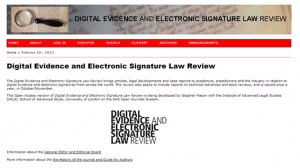As we find trending stories from high profile trials in law courts round the world featuring emails, texts and voice messages as notable evidence; as ill-advised tweets precipitate newsworthy legal action; as some ill-informed jurors supplement in court evidence with online Internet trawls and others defer their decision-making to crowd-sourced views from their Facebook friends, there couldn’t be a better time to make the Digital Evidence and Electronic Signature Law Review more widely and freely available as an open access journal.
Stephen Mason’s innovative journal has examined and anticipated these issues amongst many others since its launch as a print journal in 2004. The Digital Evidence and Electronic Signature Law Review brings articles, legal developments and case reports to academics, practitioners and the industry in relation to digital evidence and electronic signatures from across the world.
The Open Access version of Digital Evidence and Electronic Signature Law Review is now online. It has been developed by Stephen Mason (founder, publisher and general editor) with the Institute of Advanced Legal Studies on our School of Advanced Study’s Open Journals System – further raising the visibility and accessibility of the journal and its contents.
This development, through SAS OJS, will safeguard free online access to all the back issues for legal researchers, support the publication of publicly available future issues and help stimulate new areas of legal discussion and scholarship. The full back run of volumes is now publicly available on the service and we are beginning work on Volume 11 : 2014 as a “Born Digital” Open Access publication.
The Open Journal System offers a range of options to browse the journal by issue, author or by title and the search facility will check the abstracts, metadata and the individual full text PDFs for relevant materials. (Try a search for “Yahoo” to see this in action).
If you browse the contents you’ll find more than 330 items currently in the Open Access version, including articles, case notes, case translations, translations of legislation and book reports by more than 290 authors – specialist academic and professional lawyers from around the world.
For example you can see case law concerning the alteration of evidence or read papers discussing the admissibility of digital evidence, seizure of digital evidence or matters of disclosure, identity, authentication and human memory. Discover more about technology and banking, digital forensics in the cloud, electronic wills, cyber crime investigations, hacking, illegal tweets and digital data as hearsay.
A cumulative index covering Volume 1 : 2004 to Volume 10 : 2013 (available here) shows the impressive international, comparative and foreign law scope of the journal – with jurisdictional coverage so far including: Australia, Belgium, Brazil, Bulgaria, Canada, China, Croatia, Cyprus, Denmark, Dubai, England & Wales, Estonia, Finland, France, Germany, Georgia, Greece, Hungary, Indonesia, Iran, Italy, Japan, Latvia, Lithuania, Malaysia, the Netherlands, New Zealand, Norway, Poland, Romania, Russia, Singapore, Slovenia, South Africa, Spain, Sweden, Switzerland, Tanzania, Thailand, Turkey, United States of America, Uruguay, Vietnam and counting.
Volume 10: 2013 of the journal includes Stephen Mason’s Worldwide Table of Electronic Signature Legislation. A searchable web database of electronic signature legislation based on this content is being developed at IALS
http://193.62.18.232/dbtw-wpd/textbase/esiglaws.htm
Further information about the journal’s history, details of its Editorial Board and guidance notes for people interested in submitting work to the journal are available at: http://ials.sas.ac.uk/publish/deeslr/deeslr.htm
David Gee
Deputy Librarian

